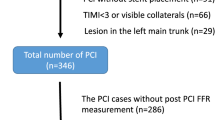Abstract
Photochemical ablation of coronary artery atheroma using pulsed xenon-chloride excimer laser has, over the past 18 months produced promising results. Worldwide experience amounts to some 2000 cases.
In the first 6 months following installation of the Dymer 200+ laser (Advanced Interventional Systems, Irvine, California, USA) at St. Thomas' Hospital, 53 procedures have been performed in 49 patients. Of these, 52.8% were ‘high risk’ (triple vessel disease, unstable angina, LV ejection fraction <35%, need to treat sole remaining coronary conduit).
Complications were two in hospital deaths (18 and 48 h post-procedure-3.8%); one ELCA related myocardial infarct (1.9%); two haemorrhage requiring transfusion (3.8%); no emergency bypass graft surgery (0%).
Current indications for the use of laser include: (1) long-segment diffuse disease; (2) proximal or ostial stenoses in coronary artery or graft; (3) restenosis after balloon angioplasty; (4) total occlusions crossed by a guidewire; (5) severe stenoses crossed by guidewire but not balloon; and (6) bifurcation lesions or stenoses compromising an important side-branch.
Potential complications include: arterial perforation; aneurysm formation; peripheral embolization by plaque material; abrupt thrombotic closure; dissection; late sudden occlusion; spasm; and restenosis.
Minor problems at the start of the programme involved: modifications to the machine to meet local laser safety requirements; special gases required for the machine; supply and design of fibre optic catheters; guiding catheters; heparin dose; dissection of the coronary artery (major and minor); and selection of patients.
Similar content being viewed by others
References
Myler RK, Topol EJ et al. Multiple vessel coronary angioplasty: classification, results, and pattern of restenosis in 494 consecutive patients.Cathet Cardiovasc Diagn 1987,13:1–15
Ernst SM, van der Feltz TA et al. Longterm angiographic follow-up, cardiac events, and survival in patients undergoing percutaneous transluminal coronary angioplasty.Br Heart J 1987,57:220–5
Homes DR Jr, Vliestra RE et al. Restenosis after percutaneous transluminal coronary angioplasty (PTCA). Registry of the National Heart, Lung and Blood Instiute.Am J Cardiol 1984,53:77C-81C
Leingruber PP, Roubin SA et al. Restenosis after successful coronary angioplasty in patients with single vessel coronary artery disease.Circulation 1986,73:710–7
Guiteras Val P, Bourrassa MG et al. Restenosis after successful percutaneous transluminal coronary angioplasty: the Montreal Heart Institute experience.Am J Cardiol 1987,60:50–8
Block PC, Myler RK et al. Morphology after transluminal angioplasty in human beings.N Eng J Med 1981,305:382–5
Lui MW, Roubin GS, King SB III. Restenosis after coronary angioplasty. Potential biologic determinants and role of intimal hyperplasia.Circulation 1989,79:1374–87
Grundfest WS, Litvak Fl et al. Laser ablation of human atherosclerotic plaque without adjacent tissue injury.J Am Coll Card 1985,5:929–33
Grundfest WS, Litvak Fl et al. Pulsed ultraviolet laser and the potential for safe laser angioplasty.Am J Surg 1985,150:220–6
Garrison BT, Srinivasan R. Microscopic model for the ablative decomposition of polymers by far ultraviolet radiation (193 nm).Appl Phys Lett 1984,44:849–51
Litvak Fl, Grundfest WS et al. Percutaneous excimer laser coronary angioplasty.Lancet 1989,ii:102
Sanborn TA, Hershman RA et al. Percutaneous excimer laser coronary angioplasty.Lancet 1989,ii:616
Karsch KR, Haase KK et al. Percutaneous coronary excimer laser angioplasty: initial clinical results.Lancet 1989,ii:647
Vallbracht C, Kaltenbach M et al. Low speed rotational angioplasty in chronic coronary artery obstructionsAmer J Cardiol 1988,62:935
Davies MJ, Thomas AC. Plaque fissuring the cause of acute myocardial infarction, sudden ischaemic death, and crescendo angina.Br Heart J 1985,53:363
Block PC. Restenosis after percutaneous transluminal coronary angioplasty-anatomic and pathophysiologic mechanisms, strategies for prevention.Circulation 1990,81:IV2-IV4
Author information
Authors and Affiliations
Rights and permissions
About this article
Cite this article
Webb-Peploe, M.M. Excimer laser coronary angioplasty: Initial experience at St. Thomas' Hospital. Laser Med Sci 6, 339–347 (1991). https://doi.org/10.1007/BF02030891
Issue Date:
DOI: https://doi.org/10.1007/BF02030891




